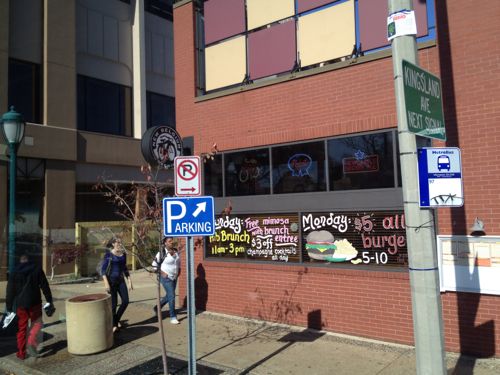Don’t Park, Parking
Signs are all around us, sometimes in confusing proximity to each other.

If you’re familiar with the Delmar Loop area you’ll likely know the blue sign is for the large parking lot behind the buildings. With so many signs is there a tipping point where they just get ignored? Placing these on separate polls/posts a few feet apart wouldn’t necessarily be an improvement.
Sign placement and effectiveness needs to be evaluated by someone, especially in busy commercial districts.
— Steve Patterson
Is anyone else confused by this? No, of course not.
The people who park in that bus stop when I want to get off the bus there.
They’re not confused, they’re jerks, playing the odds that they won’t get a ticket. And you should embrace this, as a sign of a crowded, thriving, urban area – if it weren’t, it wouldn’t be an issue!
And there should be a sign below parking, pointing to the right towards transit, saying transit. A sign below that is pointed down, saying sidewalk and a sign pointed somewhere, (where is it?) to the nearest bicycle rack.
Here’s a thought, is it possible to pretty well eliminate automobiles in the Loop? Forget the rest of the transit system except as a means to serve the Loop. Is it possible to nearly eliminate auto’s in the Loop? What does that possible look like? What is that design?
Actually the Loop is a good example of taming the auto in an urban environment. But you can still argue too much space is taken by the auto, even to the extent of hampering successful, small scale capitalism from forming. Parking is taking up land that could otherwise be used for storefronts and market space.
That’s the meaning of the signs for me. Your photo, more than anything, shows the dominance of the auto in our environment.
a few years ago Joe Edwards was on 90.7 on St Louis on the Air. my wife emailed in and asked this exact thing (“could the loop ever be auto free on weekends/nights”). Joe’s reply was “no”. as much as he liked the idea, he said Delmar was too important of thoroughfare to have auto traffic removed.
I would oppose Delmar being car-free because that would kill the street quickly. However, this bus stop is an example where the curb-line needs to bulb out, eliminating any chance of parking, so passengers can easily exit/board the bus. That means the bus would reman in the traffic lane but the motorists can wait.
And why is it “the motorists can wait”?! What makes transit riders somehow superior or special? You’re a distinct minority!
Because when we have spaces for the bus to pull over motorists park in them. Then the bus driver must let me off at a non-bus stop where I can reach the sidewalk. The public right-of-way is for all of the public. Enforcement of thousands of bus stops isn’t realistic, designing bus stops that can’t be blocked is.
If Delmar was more than two lanes wide thru the Loop area, I’d agree. But forcing the bulk of the traffic to use the turn lane (illegally) to pass a stopped bus creates more problems than it solves. And, I agree “enforcement of [parking restrictions at] thousands of bus stops isn’t realistic.” However, enforcement at a dozen in a high-traffic, high-violation area certainly is possible (but apparently not a priority). Urban life is messy, it’ll never be perfect for ANY of us, but instead of inconveniencing 90% of the population, how about nailing the 5% that are seriously inconveniencing the last 5% first?!
Parking signs are some of the most ignored signs, I think. But sign clutter contributes greatly to this as well. I used to have a great example of sign clutter that was perfect to show that once you exceed one or two, you might as well take them all down.
Laws, of which signs and paint are both manifestations, are only as effective as their consistent and ongoing enforcement. Whether it’s a car parked in a bus stop, a cyclist blowing a stop sign, a motorist throwing their cigarette butt out the window or a scooter failing to yield to a pedestrian, it’s less about a failure to notify and more about knowing that you can likely get away with it (no consequences), not paying attention and/or not knowing all the nuances of “the law”. Just putting up a “No Parking” sign, painting the curb yellow or red or painting a crosswalk won’t magically “solve” the problem (the real issue behind sign clutter), it needs to be enforced!